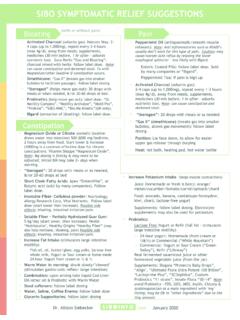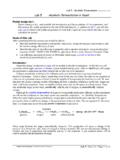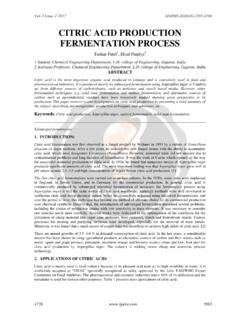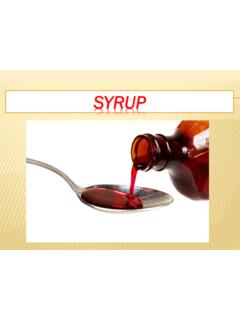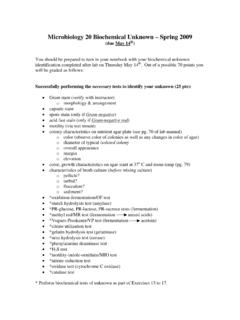Transcription of LOW FERMENTATION DIET/SIBO DIET
1 1 LOW FERMENTATION DIET/SIBO diet In the past 10 years, there has been increasing evidence that small intestinal bacterial overgrowth (SIBO) plays a role in the cause of irritable bowel syndrome. Patients have consistently asked for even more details on diet for SIBO. This new diet instruction helps provide that added detail. However, in order to understand why a diet can be helpful, you must understand what small intestinal bacterial overgrowth (SIBO) is, and why it happens. How the intestine works The intestines are compartmentalized into the esophagus (food pipe), stomach, small intestine (where all the food is digested) and colon (large intestine) (where only waste is handled and dehydrated). The slower the gut moves, the easier it is for bacteria to stay in any place. When you eat, food quickly travels through the esophagus and into the stomach.
2 The stomach acid helps denature proteins and also kills bacteria on the food you eat. The food is then delivered very slowly from the stomach into the small intestine to be further digested and absorbed into your blood. However, not all food can be processed by humans. Humans cannot process certain carbohydrates such as cellulose (most plant matter contains this). The whole time from eating to completing digestion takes about 2 hours. The small intestine is about 12 feet long. Although the colon or large intestine functions to absorb water, almost 90% of the water was absorbed by the small intestine already. So, the colon really is just for the finishing touches in dehydrating the stool, making the stool solid, and the time of passing it more convenient. Eating and Fasting It is very important for you to understand these 2 concepts before implementing the diet .
3 The human intestine is made of nerves and muscles that help move spread and absorb food. However, there are two computer modes for the intestine. These are eating mode and cleaning mode . When you are eating, the bowel is bathed in all the food you eat and the bowel is busy mixing, spreading and absorbing the food. When you are not eating, the bowel needs to clean up. This is most important in the small intestine where food is absorbed. In the small intestine, every 90 minutes, there is a strong, repetitive and moving wave that is called the housekeeper wave . It is responsible for cleaning the small bowel pushing all the leftover non-digestible material into the colon so that the next time you eat your small bowel will be clean and ready. 2 What is small intestinal bacterial overgrowth (SIBO)?
4 The human bowel has more bacterial cells than even the number of human cells in our body. This is incredible and also normal. Almost all of these bacteria are in the colon or large intestine. The reason for this is that the colon is the slowest area. The slower the bowel, the easier it is for bacteria to grow and establish. On the other hand, the small intestine normally has a low number of bacteria. This is because of stomach acid, pancreas and bile juices, the faster movement of the small bowel but most importantly the cleaning waves mentioned above. Bacteria overgrowth (SIBO) is not an infection. It is not bad bacteria. It is simply the situation of having too many bacteria of the normal kind in the small intestine. They don t belong there in high numbers. Why does SIBO occur? This is complicated and changes with more research.
5 At the moment there are many reasons for SIBO. Anything that reduces gut flow will cause SIBO. This could be blockages in the bowel, narcotic use, and other causes of mechanical slowing. However, most recently, there is link between irritable bowel syndrome (IBS) and SIBO and this is now the most common reason for SIBO. In the case of IBS, it is believed that food poisoning (getting really sick from special pathogenic bacteria after eating bad food like Salmonella, E. coli, Campylobacter, Shigella and even C. Difficile) in the past leads to this. At Cedars-Sinai Medical Center, we have determined that food poisoning and a toxin they all have, causes nerve damage to the small intestine. In part, this causes a reduction in the number of cleaning waves of the small intestine and this leads to bacterial overgrowth.
6 SIBO Think about what we said above the colon is 3 feet long and only gets trash. The small bowel is 12 feet long and is bathed in fresh, easy to use, new food. In a normal human when trash gets to the colon this is the leftover stuff that we could not digest. We could not digest it because it is hard to digest. The bacteria also have a hard time digesting it but can digest it slowly. This produces a little gas as is normal for everyone. The colon is only 3 feet long so if there is gas in there, it doesn t fill much space. Now think of the small bowel and bacterial overgrowth. You have 15 feet of bowel, now with too much bacteria in it, bathed with easy to digest fresh food. Gas is easy to produce for bacteria from this material and the small bowel takes up a lot of space. This means a lot of bloating.
7 How to Eat Now that you understand how things are supposed to work in the gut, you can start to understand how diet can help SIBO and more importantly keep it away. Unfortunately, diet alone is never enough to treat SIBO. We use the diet as a way of reducing recurrences. 3 1. Now that you understand that cleaning waves in the bowel are important to prevent bacteria build up, and that IBS has reduced cleaning waves, you can begin the diet . Every time you put food in your mouth, the computer program of the gut switches from cleaning mode to eating or digesting mode. If you put food in your mouth every hour of the daytime, you will never have cleaning waves. So the first recommendation is to eat the same amount as you normally do but that you eat it as distinct meals. Eat breakfast then don t eat anything till lunch and the same between lunch and dinner.
8 Even if you have a reduced number of cleaning waves, there may be some that come through if you spend enough time not eating between meals. We previously recommended 5 hours between meals but this can be difficult for some people. At least 4 hours is now what we recommend. 2. Don t eat right before bed. Nighttime is the longest time you are not eating. This is the time of the day where the greatest number of cleaning waves are seen. 3. Don t snack all the time. More snacking, less cleaning waves. Type of food you should eat Before we get to specifics, there are concepts you need to understand. The type of food is very important. An example I give in clinic is this. Oil can be left on the counter or in your cupboard. It does not need to be refrigerated. Ordinary bacteria cannot digest fats in isolation. So the oil does not spoil.
9 If you put a tablespoon of sugar in that oil, it will spoil. Bacteria like sugar. But keep reading because it is not that simple since humans like and need sugar too. Not everything you eat is used by you (that s why you have stool). You take what you know how to get calories from and the rest goes out as waste. However, whatever you cannot digest goes to the bacteria of the gut. They will eat part of it. When they do, they produce gas. Sugars are an important topic. Humans need sugar and bacteria use sugar. Some sugars are easier to digest than others for humans. Table sugar is easily used by humans so we grab it well before bacteria can. However, there are other sugars that humans don t grab so easily and will spread further down the gut and be shared with the bacteria. The table summarizes these Easy for humans to digest More difficult to digest Humans cannot digest Sucrose (Table sugar) Fructose (fruit sugar) Sucralose (Splenda ) Glucose Lactose (milk sugar) Sorbitol (in sugar free gum) Xylitol Lactulose Lactitol Many others 4 Gum is the greatest source of problem.
10 It often contains alcohol sugars like sorbitol. The ol at the end of the word usually means it is an alcohol sugar. Many of these sugars are synthetically designed not to be absorbed by humans. No sugar for you but all of it for the bacteria. When bacteria get sugar, they are most active in producing gas and therefore symptoms. Another principle with sugars is the concept of carbohydrates. Carbohydrates are long chains of sugars. Here to, some types humans can use, some not. Most plant carbohydrates are cellulose based and not digestible by humans. However, bacteria can digest these. diet INSTRUCTIONS: Now that you understand these concepts, these are the specifics of the diet . Try to be normal This diet is not designed to ruin your social life. Remember our goal is to make you a normal person both from symptoms and your ability to be with friend and family.
